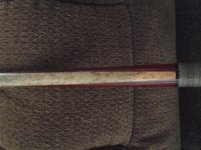Is a three point handle,
structurally more sound
and harder to make than the 4 point handle?
Or not?
I had Kikel make mine, a 3 pt in 89, and NO one has ever has noticed that it was NOT a 4 pt.
When you look at Any cue with points your never able to see all of em at once just two at a time.
Is it not allot of extra work to make 4 pts over three....is there a Good reason NO one makes 3 pt. handles. Seems like it would be less labor and materials.
Fixed autos and trucks for 17 yrs, there's always a reason why things are built/constructed in a certain way.
Constructive comments appreciated.
structurally more sound
and harder to make than the 4 point handle?
Or not?
I had Kikel make mine, a 3 pt in 89, and NO one has ever has noticed that it was NOT a 4 pt.
When you look at Any cue with points your never able to see all of em at once just two at a time.
Is it not allot of extra work to make 4 pts over three....is there a Good reason NO one makes 3 pt. handles. Seems like it would be less labor and materials.
Fixed autos and trucks for 17 yrs, there's always a reason why things are built/constructed in a certain way.
Constructive comments appreciated.

